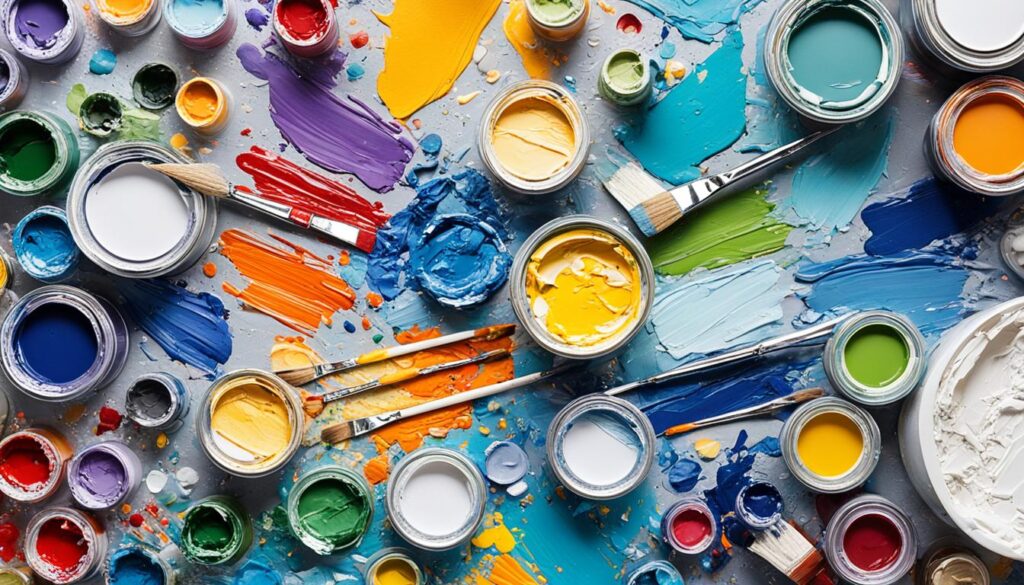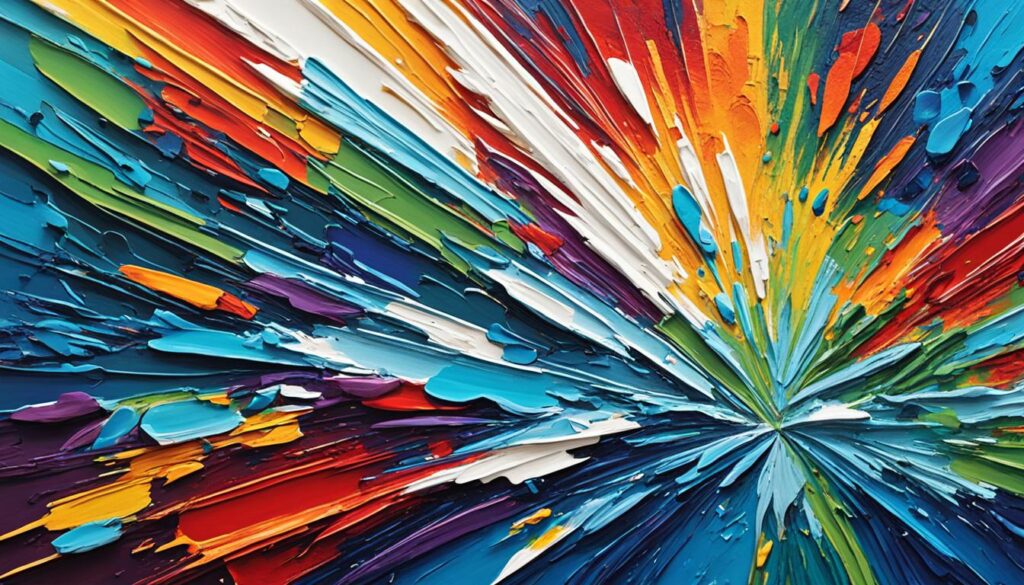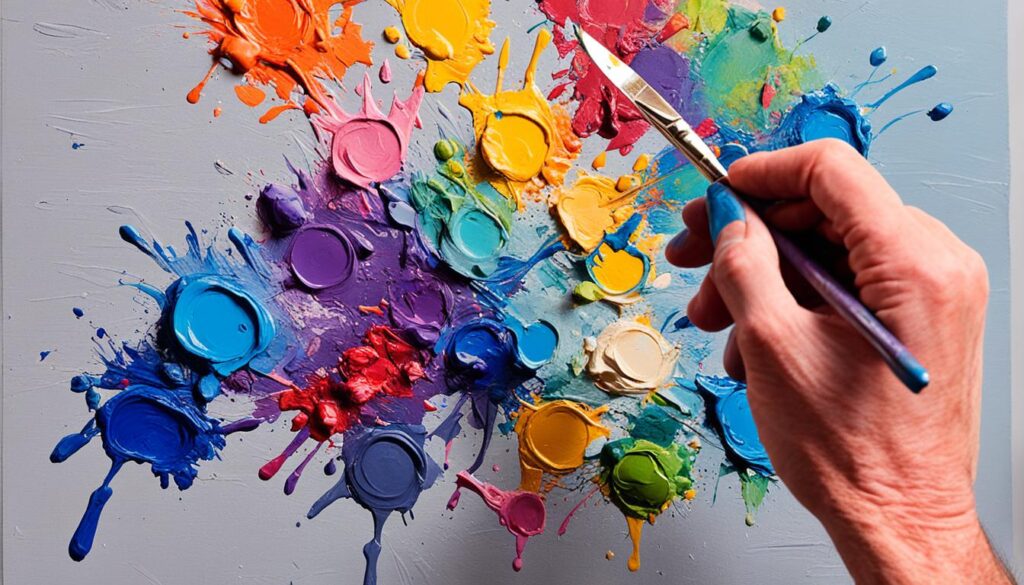This post contains affiliate links.
Ever run your fingers over a landscape, feeling every ridge of painted texture and wishing you could capture that essence on your own canvas? Imagine scooping up dollops of vibrant hues and sculpting your vision through the masterful dance of a palette knife. With impasto art techniques, your dream of captivating surfaces becomes a reality. Whether you’re just dipping your brushes into the world of acrylic impasto painting or you’re eager to refine your craft, mastering the technique of impasto in acrylic painting invites you to bring your creative impulses to life, texture by texture.
Join the ranks of Judith Bridgland and Paul Wright, and delve into this vivid world where the paint speaks as loudly as the colors it carries. It’s not just about adding a dash of dimension; it’s about embracing the rebellious spirit of artistry itself. For the brave and the bold, the impasto painting for beginners is not a mere tutorial—it’s a manifesto authored by your very hands, rooted in tradition yet fiercely contemporary.
Key Takeaways
- Understanding impasto offers a fresh dimension to acrylic painting by adding texture and movement.
- Acrylic gels can enhance the body of the paint, mimicking the thick consistency typical of oils.
- Adopting impasto painting for beginners empowers new artists to express landscapes and florals with dynamism.
- Familiarizing oneself with the tools and methods will develop proficiency in the impasto art techniques.
- Achieving mastery in acrylic impasto painting requires practice, patience, and an eagerness to experiment.
What Is Impasto: Unveiling the Charisma of Textured Art
If you’ve ever felt the itch to physically feel a painting because it looks so tantalizingly textured, you’ve likely experienced the magnetic allure of the impasto technique. Before we dive into modern acrylic impasto tips or go through a step-by-step impasto painting tutorial, let’s travel back to dig up the historical roots of this thickly painted treasure.
Historical Roots: From Rembrandt to Van Gogh
Imagine the bold brushwork of Rembrandt, giving life to every wrinkle on his storied face. It’s this textured, weathered appearance in his self-portraits that marks the early use of impasto. Fast forward to the feverish swirls of Van Gogh’s starry nights, where he took impasto mainstream, layering paint thick as butter directly from the tube to canvas. These masters didn’t just paint; they sculpted with color.
The Three-Dimensional Allure of Acrylic Impasto
Now, let’s zero in on a piece of artwork in front of you. Notice the ridges and grooves as they catch the light and cast miniature canyons of shadow? That’s the beauty of acrylic impasto. It’s more than mere paint on canvas; it’s a tactile landscape, inviting your eyes to linger and hands to (almost) touch. Artists like Claude Monet and Jackson Pollock expanded the canvas of impasto expression, resulting in its evolution into a modern art staple.
Ready to wield your palette knife like a maestro? Bear with me as we explore the fundamentals of this expressive technique:
| Component | Description | Artists’ Insight |
|---|---|---|
| Texture | The very essence of impasto, this is where you let your medium speak volumes, quite literally. | Vincent Van Gogh brought emotion to life with his vigorous textural strokes. |
| Dimension | Creating three-dimensional quality, your artwork doesn’t just depict a scene, it breathes it. | Rembrandt’s layered lighting technique introduced depth, long before 3D glasses. |
| Technique | Clever use of palette knives and brushes to define the thickness and movement of the paint. | Monet’s swift, thick brushstrokes vividly captured the fleeting effects of light and atmosphere. |
Slide into your smock and get ready to add depth and drama to your own canvas. With these acrylic impasto tips tucked into your belt and the right impasto painting tutorial, you’re just a palette knife away from creating art that leaps off the canvas and into the heart of your audience.
Essential Supplies: Gear Up for Acrylic Impasto Painting
Are you eager to dive into the thick of it with an impasto painting tutorial? Let’s get you sorted with the must-haves for your artistic exploits! Starting with high-quality acrylic paints, they’re the VIPs of texture town. Next on your checklist should be a solid gel medium, your secret weapon for adding that luscious body to your paints.

Supports matter, my friends. A swanky linen canvas or a durable wooden panel will brace your impasto strokes with their flexibility and strength. But let’s talk about your tools of texture—palette knives and various brushes. These aren’t just tools; they’re the extension of your creative soul, helping you sculpt that paint like nobody’s business!
Now, let’s not let our beautiful layers crumble under their own weight. Make sure to grab some LUKAS Painting Butter Impasto Medium to prevent any heartbreaking shrinking, cracking, or wrinkling of your paint layers. And what about maintaining that vibrant integrity of color and texture? Say hello to StudioSolv™ Odorless Mineral Spirits.
- Quality acrylic paints for vivid hues
- Gel mediums for that perfect impasto body
- Dependable canvas or wooden panels as your canvas knights
- Palette knives to lay down the texture like a boss
- Diverse brushes for every trick you’ve got up your sleeve
- Impasto mediums to keep your textures tight and right
- Odorless mineral spirits to preserve the freshness of your masterpiece
Believe me, having these essentials at hand will not only unleash your potential but also ensure a smoother ride on your impasto adventure. Remember, as you embark on this impasto painting for beginners journey, every tool and medium is a step towards becoming the impasto maestro you’re destined to be! So gear up, butter up those layers, and get ready to play the texture symphony on your canvas.
Master the Technique of Impasto in Acrylic Painting
So, you’re ready to leave flat paintings behind and add some texture to your artistic repertoire? You’re in luck because impasto in acrylic painting is about to become your new best friend. This style isn’t just about slapping paint onto the canvas—it’s a meticulous art that creates depth, with each stroke telling its own vivid story. Before we venture into the thick of it, let’s ensure you know your tools. After all, a chef is only as good as their knives, and the same can be said for an artist and their brushes and palette knives.
From Palette to Canvas: Applying Thick Acrylic Layers
You’ll begin your textured journey with a medium-toned ground on your canvas—it’s like setting the stage for an epic play. But the real fun starts when you introduce your scene builder—the trusty scenery brush or a palette knife. You’re the director here, guiding the backdrop into existence with broad, sweeping strokes. And then comes the star of the show: impasto. Those thick, luscious patches of paint that sit on the surface like whipped cream on a hot chocolate—they’re your signature, your mark of mastery.
Palette Knives and Brushes: Your Tools for Texture
Remember, in the realm of impasto art techniques, the palette knife is your wand—swirling, layering, and texturizing at your whim. Each knife has its personality and contributes differently to your canvas story—the angle, the spread, the dance of the blade—it’s all part of the choreography you’ll need to master. But don’t overlook your brushes; they bring their texture game, from stippling to blending, each one adding a subtle nuance to your piece.
Now grab those tools and show your canvas who’s boss. With palette knife and brush in hand, it’s your time to shine and master the technique of impasto in acrylic painting. Just remember, like with any great skill, impasto demands patience and practice. Your textured masterpieces await!
Capturing Nature’s Essence: Impasto for Landscape Artists
Imagine standing before a landscape where every leaf seems to ripple in the wind and every cloud floats off the canvas. This is the magic of acrylic impasto painting, a technique that transforms static images into vibrant, texturized masterpieces. It’s a favorite among artisans who dare to bend the rules of flat paint and seek to echo the wild, imperfect nuances of nature itself.
Whether you’re an experienced artist or diving into impasto painting for beginners, each stroke of the palette knife or brush adds another layer to the narrative your canvas wishes to unfold. Let’s explore how the impasto method can elevate your landscape art to a level where paint and reality dance cheek to cheek.
Impasto Landscapes: Conveying Depth and Drama
When the raw power of the elements in nature is channeled through impasto, the result is a canvas bustling with life. In the hands of a deft artist, the peaks and valleys of paint mimic the rugged contours of the Earth, turning a simple view into a dynamic scape that beckons viewers to reach out and touch the horizon.

Techniques for Highlighting and Shadowing
Even the faintest light can whisper secrets of form and substance. Using the impasto technique to apply highlights and shadows, you sculpt light into your painting like a sundial casts time upon the ground—delicate yet distinct. Your tools are but an extension of your artistic intent, whispering where the sun sleeps on a leaf or where the shadows nestle between petals.
To guide you in this tactile symphony, behold the table below that contrasts the techniques employed for highlighting and shadowing:
| Highlighting Technique | Shadowing Technique |
|---|---|
| Dry-brush with lighter hues on top of base layers | Glazing with translucent darks to deepen recesses |
| Adding pure white or yellow tints to peak points | Mixing in complementary colors to dim areas for optical depth |
| Utilizing the side of a knife for crisp edges | Feathering with a fan brush to blur boundaries |
With a bit of practice and patience—and maybe several visits to the great outdoors for inspiration—a masterful impasto painting tutorial could soon spill from your own fingertips. The landscapes you create aren’t just places; they’re experiences crafted layer by textured layer, an homage to the majesty of nature with your signature twist of drama and depth.
Color and Impasto: Crafting Emotional Impact
When you dive into the realm of acrylic impasto tips, you’ll find that color holds more power than its mere aesthetic value. It’s the heartbeat of your creation, pulsing with emotional energy. As an artist, your palette is your instrument, and with the impasto technique, you strike a chord that resonates through the textured caverns of your piece. Let’s unearth the magic of transforming pigment into passion.
With impasto art techniques, every dollop of vibrant color you mix and mold not only intensifies the visual stimuli but also amplifies the narrative whispered by each stroke. Your color choices are not just splashes on a canvas but the language with which you speak to the soul of the beholder.
| Color | Emotion | Texture Tip |
|---|---|---|
| Warm Reds | Passion and Urgency | Apply with aggressive palette knife scrapes for fervor. |
| Cool Blues | Serenity and Depth | Layer with smooth, undulating strokes for calmness. |
| Earthy Greens | Growth and Harmony | Dab with a stipple brush for organic complexity. |
| Sunshine Yellows | Optimism and Energy | Thick, bold impastos to radiate vibrancy. |
| Deep Purples | Luxury and Mystery | Manipulate with angular movements for drama. |
Remember, it’s not only the hue but the way it’s applied that weaves the visual tale. Embrace the thickness, manipulate the forms, and see how the layered richness creates a dialogue with light and shadow—each a syllable in the language of texture. Heed this: you’re not just painting; you’re orchestrating a symphony of colors that dance to the rhythm of emotions. Let’s color dramatically, with the full spectrum of our artistic spirit, and sculpt with paint to elicit the purest of responses.
Acrylic Impasto Tips for Beginners: Starting Your Journey
Embarking on the textured adventure of an impasto painting tutorial, are you? Well, you’re about to dip your brushes into something truly exhilarating! It’s more than just slapping paint onto a canvas—it’s about mastering a symphony between color and texture. Let’s turn you into a maestro in the art of thick paints!
Setting the Tone: Preparing Your Canvas
Before you summon your inner Van Gogh, let’s talk canvas. Don’t just eyeball it and hope for the best. Prepping your canvas is like setting the stage for a play—it’s got to be perfect. Apply a color ground, akin to setting the mood of your painting, dim the lights, and let the drama of acrylics begin. This all-important base is the secret sauce to ebbing seamlessly into the layering extravaganza.

Layer by Layer: Building Up Your Artwork
Now, let’s layer up like we’re heading into an art blizzard. You start broad and thin, setting the foundation before adding the whipped cream—the thick, textured details. Ever heard of the Goldilocks zone of paint and pressure? That’s your sweet spot for adding those luscious, larger impasto areas. Go on, lay it on thick with confidence and finesse!
| Material | Use in Impasto | Tips |
|---|---|---|
| Heavy Body Acrylics | Main paint | Perfect for creating rich, textured layers on your canvas. |
| Gel Mediums | Consistency Alteration | Add it to maintain vibrancy and add body to paint without diluting color. |
| Palette Knives | Application & Texture | Use for bold strokes and to achieve crisp edges or sweeping layers. |
| Various Brushes | Detailing & Blending | Choose different shapes and stiffness for unique texture effects. |
Practice is your best buddy to prevent the all-too-common mud-fest of colors nobody invited to the party. Keep it clean, keep it separate, and voilà, you’re on your way to mastering the technique of impasto in acrylic painting. Now go grab your gear and let the acrylic impasto journey unfold—one exquisitely textured stroke at a time!
Impasto Painting Tutorial: Step-By-Step Process
As you dive into the world of acrylic impasto painting, let’s break down your journey into manageable, exciting steps. From your first audacious stroke to the intricate details that give your work its soul, we’ve got you covered.
The First Stroke: Confidence in Mark Making
When you begin your impasto painting tutorial, remember that confidence is key. Every dab, stroke, and swoop with your brush or palette knife will scream intention. It’s not just about putting paint on the canvas—it’s about making each touch a concrete statement of your artistic vision. Remember, the impasto technique isn’t shy, so neither should you be.
Consider your tools as an extension of your artistic voice. Will you go bold with wide, sweeping strokes, or will you speak in hushed tones with delicate textures? Your tools are your vocabulary—the stronger your command over them, the more eloquent your impasto painting.

Complex Details: Adding Texture and Dimension
Moving beyond the foundation, the dance of adding complexity to your impasto painting begins. Now’s your chance to bring in the texture and dimension that makes this style so riveting. Sgraffito can bring to life the veins of a leaf, stippling can create the gentle nuances of light, and layering can add the body that makes your painting leap from the canvas.
| Technique | Tool Used | Impasto Effect | Artistic Tip |
|---|---|---|---|
| Palette Knife Layering | Palette Knife | Bold textures and thick layers | Apply with firm pressure for standout features |
| Brush Stippling | Stiff Bristled Brush | Fine texture, similar to pointillism | Use a light touch for subtlety |
| Sgraffito | Brush Handle or Pointed Tool | Grooves and lines through wet paint | Work decisively for crisp lines |
| Glazing | Soft Brush | Translucent layers over dry impasto | Blend gently to avoid disturbing base layers |
Each element you add not only serves a visual purpose but also contributes to the physical story of the artwork. It’s the trio of your vision, your hands, and the raw material that culminates into the acrylic impasto painting worth talking about. So grab your tools, and let’s create layers that not only capture light but also the admiration of onlookers.
Contemporary Impasto Art Techniques: Evolution of a Style
As you set out to master the technique of impasto in acrylic painting, you’re joining a storied tradition that’s constantly in motion. Today’s impasto is not your grandparent’s impasto—think of it as Impasto 2.0. With newfangled tools at your disposal, like zesty heavy acrylic gels, and the armor of quality varnishes safeguarding your masterpieces, your creative battlefield is well-equipped for innovation. Artists like Joan Eardley, who’ve elegantly wielded brushes and palette knives in service of this art style, prove that combining old-school heart with new-age tech is where it’s at.
Peek into the studios of modern maestros, and you’ll catch them blending oil with acrylics, breaking tradition like rockstars smash guitars. This cocktail of mediums cranks up the texture volume and marries the slow dance of oils with the sprightly tempo of acrylics. Revolution is in the air—or more accurately, on the canvas—as the light touch applied over established strokes unveils layer upon nuanced layer. You know that thrill that shivers your spine when you get to acrylic impasto tips no one’s ever tried before? That’s the kind of shiver-me-timbers moment we live for in impasto painting.
And of course, where would we be without the edge that impasto art techniques give us in this cosmos of viscosity and vigor? Try throwing in materials that add a glint of gloss to your gritty textures, or mix up the tactile experience with additives altering surface feel. These are not just tricks up your sleeve; they’re bona fide game-changers. As you ride this thrilling wave of texture and form, remember: the brave new world of contemporary impasto is yours for the taking—so dive, swish, and sculpt to your heart’s content!
FAQ
What exactly is the impasto technique in acrylic painting?
Impasto in acrylic painting is a bold move, my friend—it’s like adding whipped cream on your sundae. You’re piling that paint high, creating texture and a three-dimensional effect that brings your artwork to life. It’s about using thick paint layers to show off your brushwork or the character of a palette knife, giving a piece emotional depth and personality that flat paint just can’t deliver. It’s basically the paint’s way of saying, “Look at me, I can stand out too!”
Which artists are famous for their impasto work?
Oh, the list is like a who’s who of the art world’s hall of fame. We’ve got the old masters like Rembrandt, who made texture chic before it was cool, and Van Gogh, who layered paint like a boss and set the bar sky-high. Fast forward to today, and you’ve got contemporary champs like Judith Bridgland and Paul Wright, who make landscapes and florals pop off the canvas with their wicked impasto skills. They wield their brushes (and palette knives) like maestros, setting the stage for the rest of us to follow.
What is the role of gel mediums in acrylic impasto painting?
Think of gel mediums as the sidekick to your acrylics—they come in to pump up the volume of your paint, giving it the body and texture that impasto demands. They’re like the personal trainers for your acrylics. Your paint ends up with a backbone strong enough to stand up on the canvas, resisting the urge to go flat. Heavy body acrylic gels are especially buff; they’ll get your paint through a workout and keep it thick and lush, drying slowly just like the ever-patient oil paints.
How does one start an impasto painting?
Starting an impasto painting is like beginning a good mystery novel—you lay down the base, which sets the tone for everything to come. You slap on a medium-toned ground to help your composition, and then you make your first bold moves with your trusty tools, sketching in the background. After that, it’s action time, and you’re up to your elbows in thick impasto bliss, where every layer tells a story, and every texture is a plot twist. It’s a textured fairy tale on canvas!
Can you employ impasto techniques in landscape painting?
Absolutely! If you’re painting landscapes, impasto is your secret weapon for making nature jump off the canvas. It’s like giving Mother Nature a megaphone. The thick layers allow you to create texture so real, viewers might just mistake your painting for a piece of the great outdoors. Your impasto foam can almost splatter, and the petals of your florals might just sway in the gallery’s AC breeze. It’s all about bringing drama and tactile sorcery to the scene!
Why is color theory important in impasto technique?
Listen closely because I’m about to drop some knowledge—color theory in impasto is as crucial as cheese in pizza. When you’ve got those thick, impasto layers, every hue is not just a color; it’s a declaration of emotion, a shout-out to your artistic vision. You’ve got to know how to mix your colors to maintain their integrity when they’re six inches off the canvas. It’s all about making sure your textured masterpiece has soul, and that’s where color theory comes waltzing in, all suave-like.
Any acrylic impasto tips for someone brand new to the technique?
New to the impasto league? No worries! Start with prepping your canvas with a colored ground—it’s like setting the stage before the headliner rocks the concert. From there, think of your painting like a crescendo in a symphony: start soft and broad, then build up to those big, textured notes. Keep your movements confident, your colors unmuddled, and, most importantly, have fun with it. It’s like learning to dance—you might step on some toes at first, but before you know it, you’ll be waltzing across that canvas!
How do you add fine details with the impasto painting technique?
Fine details in impasto are the cherry on top of the sundae. Techniques like sgraffito come in handy—scraping back layers to reveal whispers of colors underneath or using the dead-ass precision of a tiny brush to add those meticulous touches. It’s all about marrying the boldness of impasto with the intricate dances of finer details. Think of it as the grand finale—a firework show of texture and depth that leaves the crowd awe-struck.
What are some modern innovations in impasto technique?
The impasto technique today is like a tech start-up—always innovating, never staying still. Artists mix new mediums, dabble in various varnishes, and have even been known to cross the streams with acrylics and oils. New tools mean new textures, and quality ingredients mean your impasto will age like a fine wine. It’s a continuous evolution, a never-ending art party where the theme is ‘let’s make some textured waves’!
Source Links
- https://www.jerrysartarama.com/blog/impasto-techniques-the-masters-used/
- https://atrusovaartist.com/blog/mastering-impasto.html
- https://www.artistsandillustrators.co.uk/how-to/oil-painting/how-to-perfect-your-impasto-painting/
This post contains affiliate links.

